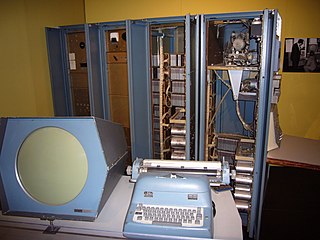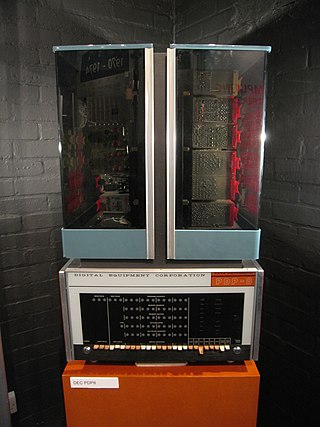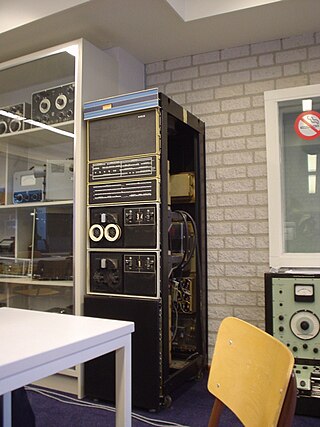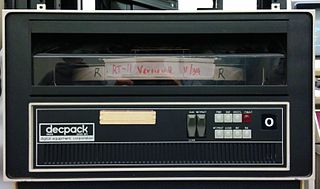Related Research Articles

Digital Equipment Corporation, using the trademark Digital, was a major American company in the computer industry from the 1960s to the 1990s. The company was co-founded by Ken Olsen and Harlan Anderson in 1957. Olsen was president until forced to resign in 1992, after the company had gone into precipitous decline.

Programmed Data Processor (PDP), referred to by some customers, media and authors as "Programmable Data Processor," is a term used by the Digital Equipment Corporation from 1957 to 1990 for several lines of minicomputers.

The PDP-8 is a 12-bit minicomputer that was produced by Digital Equipment Corporation (DEC). It was the first commercially successful minicomputer, with over 50,000 units being sold over the model's lifetime. Its basic design follows the pioneering LINC but has a smaller instruction set, which is an expanded version of the PDP-5 instruction set. Similar machines from DEC are the PDP-12 which is a modernized version of the PDP-8 and LINC concepts, and the PDP-14 industrial controller system.

The PDP–11 is a series of 16-bit minicomputers sold by Digital Equipment Corporation (DEC) from 1970 into the late 1990s, one of a set of products in the Programmed Data Processor (PDP) series. In total, around 600,000 PDP-11s of all models were sold, making it one of DEC's most successful product lines. The PDP-11 is considered by some experts to be the most popular minicomputer.
RT-11 is a discontinued small, low-end, single-user real-time operating system for the full line of Digital Equipment Corporation PDP-11 16-bit computers. RT-11 was first implemented in 1970. It was widely used for real-time computing systems, process control, and data acquisition across all PDP-11s. It was also used for low-cost general-use computing.

The PDP-6, short for Programmed Data Processor model 6, is a computer developed by Digital Equipment Corporation (DEC) during 1963 and first delivered in the summer of 1964. It was an expansion of DEC's existing 18-bit systems to use a 36-bit data word, which was at that time a common word size for large machines like IBM mainframes. The system was constructed using the same germanium transistor-based System Module layout as DEC's earlier machines, like the PDP-1 and PDP-4.
OS/8 is the primary operating system used on the Digital Equipment Corporation's PDP-8 minicomputer.
DIBOL or Digital's Business Oriented Language is a general-purpose, procedural, imperative programming language that was designed for use in Management Information Systems (MIS) software development. It was developed from 1970 to 1993.

DECtape, originally called Microtape, is a magnetic tape data storage medium used with many Digital Equipment Corporation computers, including the PDP-6, PDP-8, LINC-8, PDP-9, PDP-10, PDP-11, PDP-12, and the PDP-15. On DEC's 32-bit systems, VAX/VMS support for it was implemented but did not become an official part of the product lineup.

The PDP-15 was the fifth and last of the 18-bit minicomputers produced by Digital Equipment Corporation. The PDP-1 was first delivered in December 1959 and the first PDP-15 was delivered in February 1970. More than 400 of these successors to the PDP-9 were ordered within the first eight months.

The Professional 325 (PRO-325), Professional 350 (PRO-350), and Professional 380 (PRO-380) are PDP-11 compatible microcomputers introduced in 1982 by Digital Equipment Corporation (DEC) as high-end competitors to the IBM PC.
Pertec Computer Corporation (PCC), formerly Peripheral Equipment Corporation (PEC), was a computer company based in Chatsworth, California which originally designed and manufactured peripherals such as floppy drives, tape drives, instrumentation control and other hardware for computers.

DECmate was the name of a series of PDP-8-compatible computers produced by the Digital Equipment Corporation in the late 1970s and early 1980s. All of the models used an Intersil 6100 or Harris 6120 microprocessor which emulated the 12-bit DEC PDP-8 CPU. They were text-only and used the OS/78 or OS/278 operating systems, which were extensions of OS/8 for the PDP-8. Aimed at the word processing market, they typically ran the WPS-8 word-processing program. Later models optionally had Intel 8080 or Z80 microprocessors which allowed them to run CP/M. The range was a development of the VT78 which was introduced in July 1977.

Digital Equipment Corporation's RK05 is a disk drive whose removable disk pack can hold about 2.5 megabytes of data. Introduced 1972, it is similar to IBM's 1964-introduced 2310, and uses a disk pack similar to IBM's 2315 disk pack, although the latter only held 1 megabyte. An RK04 drive, which has half the capacity of an RK05, was also offered.
TSS/8 is a discontinued time-sharing operating system co-written by Don Witcraft and John Everett at Digital Equipment Corporation in 1967. DEC also referred to it as Timeshared-8 and later the EduSystem 50.

The PDP-8/e was a model of the PDP-8 line of minicomputers, designed by the Digital Equipment Corporation to be a general purpose computer that inexpensively met the needs of the average user while also being capable of modular expansion to meet the more specific needs of advanced user.

The PDP-12 was created by Digital Equipment Corporation (DEC) in 1969 and was marketed specifically for science and engineering. It was the third in the LINC family and its main uses were for applications in chemistry, applied psychology, patient monitoring and industrial testing. It is the combination of the LINC computer and the PDP-8 and can run programs for either computer. It features a single central processor with two distinct operating modes, each with its own instruction set that allows it to run both computers' programs. PDP-12 Basic System weighed about 600 pounds (270 kg).
Synergy DBL is a compiled, imperative programming language designed for business use. The language was originally called DBL; later it was referred to as Synergy Language; as of 2012 the official name is Synergy DBL. It is based on Digital Equipment Corporation’s DIBOL programming language.
Interactive Application System (IAS) was a DEC operating system for the PDP-11. It was a fork from RSX-11D.
BASIC-8, is a BASIC programming language for the Digital Equipment (DEC) PDP-8 series minicomputers. It was the first BASIC dialect released by the company, and its success led DEC to produce new BASICs for its future machines, notably BASIC-PLUS for the PDP-11 series. DEC's adoption of BASIC cemented the use of the language as the standard educational and utility programming language of its era, which combined with its small system requirements, made BASIC the major language during the launch of microcomputers in the mid-1970s.
References
- 1 2 3 DIGITAL EQUIPMENT CORPORATION - Nineteen Fifty-Seven To The Present (PDF). Digital Equipment Corporation. 1978.
- ↑ Binh Nguyen. Linux Dictionary. p. 424., citing "QUECID".
- ↑ "Time-Sharing Uses Emphasized For DEC Datasystem 350 Series". Computerworld. July 30, 1975. p. 19.
Dibol Under COS: The series operates under the Commercial Operating System (COS) 350, which provides timesharing with a high-speed response.
- ↑ PDP 8/e Small Computer Handbook. Digital Equipment Corporation. 1973. pp. 2-19 thru 2-20.
- ↑ "Time-Sharing Uses Emphasized For DEC Datasystem 350 Series". Computerworld. July 30, 1975. p. 19.